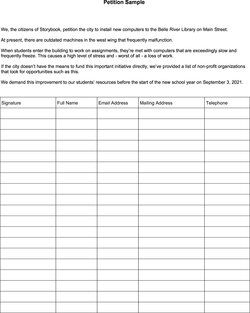How To Create Petition On Facebook
How to Write a Petition
If you have a burning desire to elicit change in your community, a petition can be a powerful tool. Armed with supporters, you can take your petition to the appropriate authorities and build a solid case for your cause. When thinking about how to write a petition, it's important to keep one thing in mind: specificity. This isn't the time for blanket statements or wishy-washy demands. It's the time for a detailed call to action and thorough research in support of your cause. Believe it or not, all that can be wrapped up in a few tidy paragraphs.
 How to Write a Petition
How to Write a Petition
The great thing about petitions is that they can be delivered via hard copy or an electronic link. Each of the steps below will help you create a strong document to share with others.
1. Research Your Topic
This is the first step in writing your petition. You can't take any action steps until you've thoroughly researched your cause and understand all that it entails. For example, if you want to petition your local government for a library expansion, it's necessary to understand the pertinent rules and regulations for such an endeavor. Then, you can make the most meaningful (and specific) request on behalf of your townspeople.
2. Determine How Many Signatures You Need
Most government entities have specific guidelines regarding how many signatures are needed to put a petition into effect. So, depending on where you'd like to submit your petition, be sure to ascertain the number of signatures required before you embark on your journey.

View & Download PDF
3. Develop a Statement of Purpose
A statement of purpose is essential for two reasons. First, it will bolster your powers of persuasion with potential signees. Second, it's the cornerstone of the petition itself. Your statement will include a simple, concise sentence that frames a very specific goal.
For example, you don't want to write, "We need a new annex for our local library." Rather, you'd want to write something along the lines of "We demand more research opportunities for our children and residents, and only an additional wing to house these resources will do."
4. Add Supporting Detail
Once you've framed your statement of purpose clearly and concisely, it's time to expound upon your cause. You can dive a little deeper into your specific intentions. You'll want to draft a paragraph or two that include the following details:
- The nature of the problem
- Why it needs to be fixed
- A specific call to action that will address the issue
Be sure that anyone reading the petition will understand the nature of the problem as well as your proposed solution. Don't get too technical here. Leave this portion to just a paragraph or two. Otherwise, you'll lose your audience in a sea of lengthy facts and statistics.
5. Cite Your References
If you cite any statistics relating to the community or its history, be prepared to provide ample citation. You can do this directly in the petition with footnotes. Cite any newspaper references or online research, so potential signees will know you mean business and are armed with accurate and powerful information.
6. Create a Form for Signatures
With all your information intact, it's time to create the actual form people will sign. This can be done in a word processor or spreadsheet.
Begin with a cell for people to sign, and then arrange further cells to the right for their printed name, address, and telephone number. This will be crucial later on down the line because it will prove all your signees live in the area that will be impacted by the decision.
7. Solicit Signatures
With your statement of purpose, supporting detail, references, and signature form all in place, it's time to solicit the actual signatures from community members. Start with any public places where your signees are likely to spend their time. Spread the word through your workplace, friendships, and neighbors.
You might want to consider promoting your petition online, through Facebook friends and with relevant community Facebook groups. The online version of your petition will work hand in hand with a physical copy.
It'll look just the same as the hard copy, with a statement of purpose, supporting detail, and a place to sign. Just send the direct link to the online form, and friends and neighbors will be all set to support your worthy cause.
8. Be Patient
Most people won't be quick to add their signature and personal information to a form, even if they know you. Remember to be patient, rather than forceful.
If you're soliciting signatures in person, take a gentle approach and don't keep pushing the issue if anyone seems hesitant to jump on board. Perhaps you'll leave them with some literature or your two paragraph write-up on the issue. The same goes for an online version. Don't inundate people with e-mails or Facebook posts beyond your initial point of contact.
Rather, send a gentle reminder once or twice and then leave it at that. Hopefully, your statement of purpose and supporting detail will be strong enough to sway a few signatures from your target audience.
Be the Voice of Change
With a thoroughly-developed petition in hand, you're ready to go out there and be the voice of change. Don't allow yourself to get disheartened if people don't immediately jump on board. Rather, be armed with additional resources that back your claim. Although you may not garner a signature from someone right away, they may come back around to support you after further investigation.
Have you ever had success with a local petition? If so, feel free to join the conversation in the comments section below!
How To Create Petition On Facebook
Source: https://grammar.yourdictionary.com/grammar/writing/how-to-write-a-petition.html
Posted by: murphyussighboult1999.blogspot.com

0 Response to "How To Create Petition On Facebook"
Post a Comment